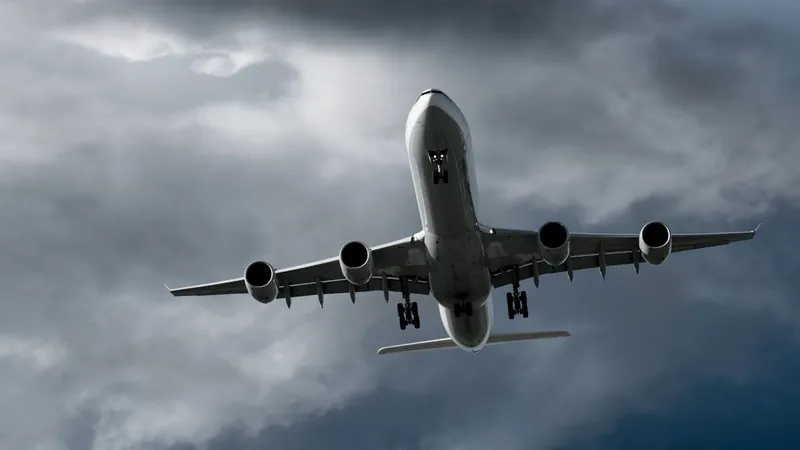
Say Goodbye to Bumpy Flights! How AI is Set to Revolutionize Air Travel by Tackling Turbulence
2024-11-11
Author: Arjun
Introduction
In an exciting breakthrough that could change the way we fly, scientists have revealed a cutting-edge technique designed to combat the turbulent woes of air travel. The focus of this groundbreaking research is on unmanned aerial vehicles (UAVs), but the implications may soon extend to commercial passenger planes.
Understanding Turbulence
Turbulence—those unnerving jolts passengers feel during a flight—is caused by rapid changes in air pressure. While flying creatures like birds instinctively sense these variations and adjust their flight patterns to achieve smooth gliding, airplanes have struggled with this natural phenomenon for decades.
The AI Breakthrough: FALCON
A study published on September 24th in the peer-reviewed journal NPJ Robotics has introduced an artificial intelligence system named FALCON, which has been engineered to dynamically adjust an aircraft's flight path in real-time, effectively adapting to turbulence as it occurs.
Innovative Features of FALCON
What sets FALCON apart from previous AI systems is its application of reinforcement learning—an innovative AI training method that empowers it to model turbulence in a comprehensive manner. Unlike earlier systems that were confined to specific environments, FALCON has been trained to grasp the fundamental principles of turbulence, allowing it to respond to a wide range of flight conditions.
Mathematical Foundation of FALCON
The methodology behind FALCON is based on advanced mathematical concepts known as Fourier methods. These involve using intricate sine waves to digitally represent data about wind conditions, effectively turning the chaotic nature of turbulence into a model that can be analyzed and countered.
Real-World Application and Testing
According to Hever Moncayo, a professor of aerospace engineering at Embry-Riddle Aeronautical University, the real-time adaptation capability of FALCON is impressive. "It learns the underlying turbulence model," he said, pointing out that modern computational systems, like Nvidia Jetson, can facilitate this sophisticated integration of AI learning and analysis, making the technology incredibly feasible.
During tests conducted at Caltech's wind tunnel, researchers implemented FALCON on an airfoil wing designed to mimic UAVs, attaching pressure sensors to enable the AI to monitor changes in airflow. It was subjected to random turbulent conditions via a movable cylinder, with FALCON iteratively learning how to adjust the wing's angle to maintain stability. Remarkably, after just nine minutes of learning, the AI succeeded in stabilizing the wing under challenging conditions.
Future Prospects and Challenges
Moncayo emphasized that these wind tunnel tests indicate FALCON's potential scalability for larger commercial aircraft. However, challenges remain in achieving rapid adaptation to unpredictable real-world conditions, as well as validating its performance across diverse UAV models and varying flight environments.
In an ambitious vision for the future, researchers are also exploring the idea of implementing an interconnected system where aircraft could share environmental data with one another. This could potentially warn pilots about impending turbulence. However, the cyclical threat of cybersecurity issues surrounding aircraft control systems poses significant hurdles, necessitating rigorous testing and robust security measures.
Conclusion and Next Steps
"Future development will focus on enhancing prediction accuracy and minimizing training times, which are both essential,” Moncayo explained. The next phase of the research aims to speed up FALCON's learning mechanism—an essential step to ensure its practicality and effectiveness when applied to commercial air travel.
As the aviation industry grapples with passenger comfort and safety, the promise of artificial intelligence in combating turbulence can usher in a new era of smoother, more enjoyable flights—a true game-changer that could redefine our aerial experiences!




 Brasil (PT)
Brasil (PT)
 Canada (EN)
Canada (EN)
 Chile (ES)
Chile (ES)
 España (ES)
España (ES)
 France (FR)
France (FR)
 Hong Kong (EN)
Hong Kong (EN)
 Italia (IT)
Italia (IT)
 日本 (JA)
日本 (JA)
 Magyarország (HU)
Magyarország (HU)
 Norge (NO)
Norge (NO)
 Polska (PL)
Polska (PL)
 Schweiz (DE)
Schweiz (DE)
 Singapore (EN)
Singapore (EN)
 Sverige (SV)
Sverige (SV)
 Suomi (FI)
Suomi (FI)
 Türkiye (TR)
Türkiye (TR)